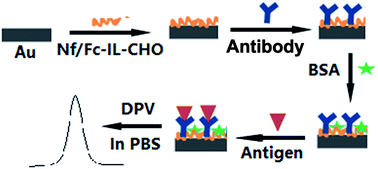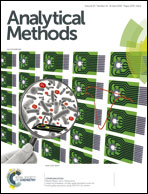A versatile matrix of an ionic liquid functionalized with aldehyde and ferrocene groups for label-free electrochemical immunosensors†
Abstract
A novel ionic liquid functionalized with aldehyde and ferrocene groups was successfully synthesized. It was used to develop a label-free electrochemical immunosensor for the detection of human immunoglobulin G by casting this multifunctional ionic liquid entrapped in a Nafion matrix on a gold electrode. This multifunctional material was redox-active because of the introduction of ferrocene on the surface of the electrode through the covalent attachment of ferrocene to the ionic liquid, which avoided the use of other redox species in the electrolyte solution. In the meantime, the covalent attachment also avoided signal decrease resulting from the leakage of ferrocene into solution. In addition, the versatile ionic liquid can be used as a substrate for direct antibody immobilization due to the existence of the aldehyde group, which greatly simplified the process of sensor fabrication. The proposed sensor exhibited a good performance in a linear range from 0.05 to 35 ng mL−1 with a detection limit of 0.03 ng mL−1 based on 3σ and provided a novel strategy for clinical detection due to its satisfactory stability, selectivity and reproducibility.



 Please wait while we load your content...
Please wait while we load your content...